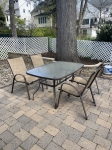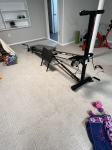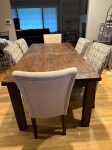Frozen Piple
you can have the pipe moved out of the wall and into the cabinet.
Can you insulate around the pipe? If not, moving it might be the best option.
Leave the cabinet doors open at night to let the heated room air in to the cabinet.
We have not one, but TWO outside faucets that do NOT have cutoff valves. In years past we never had a problem with freezing, but last winter's extreme temps had me shaking in my boots so we finally addressed the problem. We brought a heating cable made to wrap around pipes (I don't recall its official name). This won't help you with the current frozen pipe, but it is something to look into to keep the problem from recurring. I bought them at Home Depot and it was an easy DIY install for us since in our case the pipes were easily accessible from the basement.
Don't know if this is true, but I heard that if you leave your faucet on a slow drip, pipe won't freeze. That is what I usually do when it is this cold, never have had a frozen pipe since moving here in 1974. Also, leave your cabinet doors open. I can't do this because of my cat.
If the pipes run are run inside the wall, instead run the pipes inside the cabinet.
Assuming the basement isn't finished, this isn't a huge job.
That said, if the piping that supplies water to the kitchen then also goes up to another floor, its a much bigger fix, but if that were the case, more than your kitchen would be impacted.
I moved into a new (old!) house a few months back, this is my first winter in this house -- and I'm
a) leaving the cabinet doors open in the bathrooms and kitchen
b) put a small (200 watt) heater near the pipes that to me might be most vulnerable
c) leaving the water drip -- which I think is particularly important at night when its this cold (single digits)
best during this cold snap!
we have the same problem we leave cabinet doors open and let the water drip. If we do this we do not have a problem the pipes are insulated as is the space through which they pass it doesn't seem to matter we still need to let it drip
Here are some helpful suggestions: http://www.wikihow.com/Unfreeze-Water-Pipes
Yes to all of the above- make sure both taps are open for the drip. It's actually our hot water pipe that freezes most often.
However, even with all of that, our vulnerable pipe still froze and burst last year in that unbearably cold stretch. Finding a long-term solution to the pipe is really best if you can!
Two well documented facts to keep in mind when looking at these types of problems.
Hot water pipes will always freeze first. Because it was heated, the water has fewer minerals and oxygen in it. Thus it will freeze before the cold water.
Insulation will not solve the problem. It will slow the processed down. Insulation is good in that the transfer of heat (gain or loss) will be slower, but insulation alone will not stop a freeze. When warm insulation will tend to keep something warm longer or slow down the loss of any heat, but once the heat is lost it is lost. Your Freezer is insulated and that keeps the cold in.
So, insulation between the pipe and the outside wall, with exposure to heat on the inside is a good plan.
We had that problem in our West Orange house. On the plumber's advice, we moved the pipes out of the wall and into the cabinet. We even moved the supply pipes out of the wall and right into the rooms (small basement bathroom and laundry room) so they would never be at risk again.
For Sale
Free Items
Featured Events
-
Stephen Whitty Presents - Hometown Movie Stars: The Celebrated Actors Of CHS
May 6, 2024 at 7:00pm

































When we bought our house it had a beautifully renovated kitchen. We soon discovered that the contractor placed a pipe for the sink too close to an outside wall. In cold weather, the water freezes in the pipe. I'm tired of it!
Please suggest:
1. a short term fix to unfreeze the pipe (i've had a hair dryer on it for the past 30 minutes)
2. someone who can advise on how to avoid this ever happening again.
Thanks!